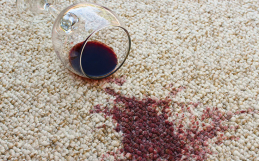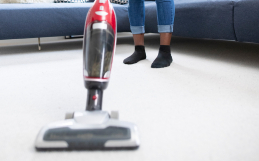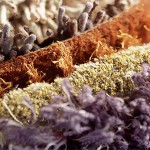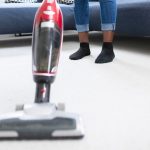There is any number of reasons why your carpeting can get wet and varying degrees of “wetness.” Spilling a big glass of water isn’t nearly as bad as having heavy rains flood a carpeted basement. However, in both cases, time is of the essence when it comes to figuring out how to dry wet carpet.
A small spill is easily dispatched by blotting the wet area: simply put a towel on the spill, step on it a few times, and lift. The water is absorbed into the towel and you’re set. Trying to wipe up the spill will just spread the water around. If it still feels damp, consider using a fan or even a hairdryer to dry the remaining water.
But if it’s a leak that has soaked the whole carpet, more aggressive methods are needed. This usually is the result of a leaky roof, a sudden problem with plumbing, or basement flooding caused by heavy rains and poor drainage at the foundation. Or maybe it was a slow steady leak over a three-day weekend while you were away.
In any case, you’ll want to dry the carpet quickly.
Drying Your Wet Carpets
If dampness has spread throughout the room, there are steps you can take to remedy the situation on your own. Renting a wet-dry vacuum from the hardware store will get most of the water up. Running ceiling fans or box fans will increase air flow, which also helps speed up the drying process.
Unfortunately, you may still have to pull up the carpet and remove the padding underneath. There could be trapped moisture between the carpet and the padding. If there is still excess water or standing water on the padding, it makes sense to call in a professional carpet or water damage restoration service.
If the water has reached the subflooring or has been soaked into the walls, simply drying the carpet will not be enough. You may need to remove and replace the carpet padding before putting the carpet back down. And you’ll want to remove any baseboards, drywall, or trim that has been soaked through.
Consider the Source of the Leak
In some cases when the carpet is wet, you can simply dry it out and be done with it. If the water comes from a leaky roof or burst pipe, it’s relatively clean water. Sprinkling some baking soda on the area after drying and letting it sit for a bit before vacuuming can remove any odors. You can also hire a professional carpet cleaning company.
If the leak is from gray or black water, you’ll want to clean the carpet as well–quickly. Gray water is water that comes from the sink, shower, or bathtub drains. Blackwater means the septic drain lines are involved, leaving a foul odor that no carpet cleaning can remove. It’s time to rip it all out and install the new carpeting.
A small puddle of water is easy enough to deal with, and even if unnoticed for a few hours, won’t cause that much damage. It will dry soon enough with just the ambient heat of the home and in most cases won’t reach the sub-flooring. If you don’t know how to dry a wet carpet, it can lead to real issues.
Wet Carpet Issues
Mold: Black mold is a common household problem when water is present for long periods of time. Wet carpeting inside the home makes for perfect conditions for mold growth because it’s warm enough to encourage growth. When it dries, it becomes airborne and can cause all kinds of respiratory problems.
When black mold is present, everything that is in contact must be removed from the house. It’s not enough to just remove the visible mold because it could be deeply embedded in the fibers, carpet padding, and even the subflooring.
Just like the mold can get into the carpet fiber and padding, it can also spread to your walls. You could be forced from home for however long it takes to remove the mold (and drywall or rotting framing). We recommend a full inspection from a reputable restoration company to ensure your family’s safety.
Gray or Black Water: As we said before, a carpet cleaner may not be enough to remove the smell from wastewater. It could also carry pathogens that, once airborne, could cause serious health problems for individuals living in the home.
Structural Damage: If water was allowed to sit for too long, it could seep into the subflooring and even the framing of the home. Dry rot is common when there are persistent leaks, although usually limited to areas around fixtures that haven’t been maintained. Basically, the moisture just eats away at the wood until it becomes brittle.
Prevent Water Damage
If you continue to experience wet or damp carpets even after you’ve taken restorative measures, there could be more pressing issues. Problems with your roofing, plumbing, or foundation must be addressed or else you’ll be in a constant state of drying (or replacing) your carpet.
French drains along the foundation or a submersible pump in the low corner of a basement can help prevent water from entering the house or pooling. No matter how the water is getting into the house, consulting a building professional to help you answer those questions will help protect your home.









